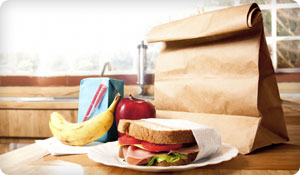
Parents are becoming increasingly concerned about the foods school cafeterias serve, which tend to be high in calories, fat, sugar, and salt, and offer very little nutritional value. As a result, many parents are beginning to send their kids to school with a packed lunch.
But did you know that food in lunch bags can get warm enough by lunchtime to encourage the growth of bacteria, and could even make your child ill?
A study that measured the temperature of 700 preschoolers' lunch bags found that in 90 percent of the cases, the temperature in the bag climbed to 60°F or higher by lunchtime. Perishable food starts becoming unsafe above 40°F.
Here are some tips for ensuring your child brings a healthy—and safe—lunch to school.
- For optimal nutrition, include 100 percent whole grains, one uncut fruit, one vegetable, a protein source, and nuts in each lunch.
- Only pack what your child can eat in one sitting to avoid leftovers.
- Practice safe food preparation. Wash your hands with soap before handling food, and keep cutting boards and knives separate for meats, produce, and non-cooked foods.
- Use an insulated, soft-sided bag to carry the lunch. Avoid carriers made from vinyl (PVC) and make sure they are lead free. You can also use metal or plastic bags and boxes.
- Keep perishables cold or frozen, including prepackaged combination meals, and transport them as quickly as possible. Don't leave perishables at room temperature for more than two hours (one hour if the temperature is over 90 degrees F).
- Include frozen ice packs in the bag with perishable food. If you're also sending a drink for your child, freeze it and pack it along with the ice pack.
- Keep hot foods at least 140 degrees F or higher. Use a thermal container to transport and store hot food.
- Avoid anything with mayo if you can't keep it sufficiently cold until lunch.
- According to the Virginia Cooperative Extension, you should keep these foods cold:
- Meat, fish, poultry
- Eggs
- Cooked beans (including sandwiches or salads made with beans)
- Tofu, soy, or meat substitute products
- Milk and cheese
- Custards and pudding
- All cooked vegetables
- Sprouts
- Cut melon
- cooked grains (or dishes with)
- Gravies, sauces, mayo, and butter
- Foods that are safe at room temperature include:
- Nuts and nut butters
- Unopened, shelf-stable milk, vegetable, puddings, and fruit juices
- All fresh and dried fruits
- Bread, crackers, dry cereals
- Candy
- Ketchup, mustard, margarine, oil
- Fruit pies
Sources:
HealthVideo.com. "Your kids' lunches could be rotting." Web.
http://topics.healthvideo.com/m/46676456/your-kids-lunches-could-be-rotting.htm
U.S. Department of Agriculture. Food Safety and Inspection Service. "Keep 'bag' lunches safe." Web. 15 December 2010. http://www.fsis.usda.gov/Fact_Sheets/Keeping_Bag_Lunches_Safe/index.asp
Conde, Crystal." Tips for Packing a Healthy Packed Lunch." Huffington Post. Web. 1 November 2011. http://www.huffingtonpost.com/2011/11/01/healthy-packed-lunch_n_1068775.html
YouBeauty.com. "10 Healthy Brown Bag Lunches." Web. 27 October 2011.
http://www.youbeauty.com/nutrition/galleries/ten-healthy-brown-bag-lunches#1
Forrester, Mena. "Safe Brown Bag Lunches." Virginia Cooperative Extension. Web. 1 May 2009.
http://pubs.ext.vt.edu/2806/2806-7003/2806-7003.html





